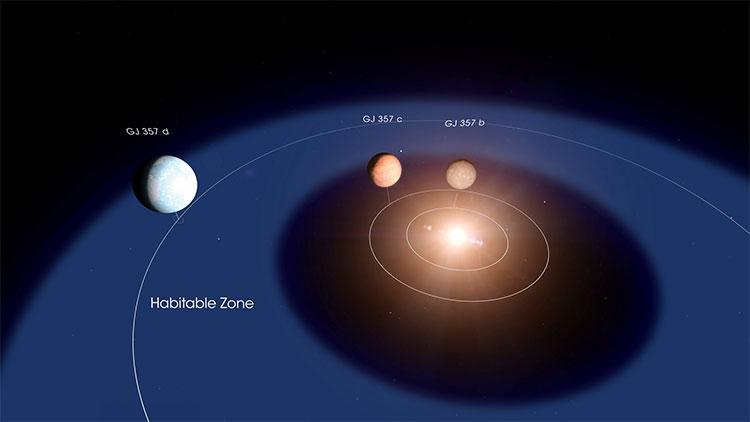Is there a 2nd Earth, only 31 light-years away?
GJ 357 d has a temperature of about 18 degrees Celsius, completing an orbit around its star of 55.7 days.
After completing the first year of observations in the southern sky, TESS of the US Aerospace Agency discovered many remarkable exoplanets.
Extraterrestrial planets - planets orbiting stars outside our solar system, have been discovered orbiting a dwarf M, GJ 357 in the constellation Hydra.
This star is 40% cooler than our Sun and is only one-third the mass and size of the Sun.

Images depicting newly discovered exoplanets.
Remarkably, the first alien planet discovered around the star is GJ 357 b. This planet is 22% larger and 80% stronger than Earth.
The researchers estimated that it had an average temperature of 254 degrees C. After 3.9 days, it completed an orbit around the GJ star 357 b.
Enric Pallé, astrophysicist at the Canary Institute of Astrophysics, co-author of the study, said: "GJ 357 b is a hot Earth. Although it cannot store life, it is worth noting. I mean, the third closest planet is known to date when there is an atmosphere. "
In addition, scientists discovered GJ 357 c , 3.4 times the mass of Earth and dragged around the planet after 9.1 days. GJ 357 c also reaches a temperature of 127 degrees Celsius - quite hot for us to live.
Most notably, GJ 357 d , referred to as the "Second Earth", has a mass of 6.1 times the Earth, orbiting the star at a distance where the temperature may be suitable to support liquid water. on the surface.
Specifically, GJ 357 d has a temperature of about 18 degrees Celsius, completing an orbit around its star of 55.7 days.
Diana Gossakowski, research co-author at Max Planck, said: "GJ 357 d is at the outer edge of the star's habitable region. Here, it receives the same amount of energy from its star as Mars with the Sun ".
If the planet has a dense atmosphere, scientists will carry out further studies to determine whether it has enough heat to warm the planet and liquid water on the surface to create good life. is not.
- Which new planet is "2nd Earth"?
- How important is the discovery of "Second Earth"?
- Video: Lighting the Earth for 6 years from the ISS station
- Discovering the planet 13,000 light-years away from Earth
- How far can we stand from the Earth, can we see living dinosaurs?
- The US produces about one billion light-years of sunlight
- Young Jupiter-like planet is 97 light-years away from Earth
- Create a map that fills the gap of 500 million years of Earth history
- Catch the light from super-earth
- Discover new planet 21 light-years away from Earth
- Increasingly cold sun?
- Discover the first oxygen molecule 1,500 light years from Earth
- Photographing the planet 300 light years from Earth
- A light-year ... 225 million years of walking
 Van Allen's belt and evidence that the Apollo 11 mission to the Moon was myth
Van Allen's belt and evidence that the Apollo 11 mission to the Moon was myth The levels of civilization in the universe (Kardashev scale)
The levels of civilization in the universe (Kardashev scale) Today Mars, the sun and the Earth are aligned
Today Mars, the sun and the Earth are aligned The Amazon owner announced a secret plan to build a space base for thousands of people
The Amazon owner announced a secret plan to build a space base for thousands of people The 'red monster' that Sima Qian mentioned caused illusions on Earth?
The 'red monster' that Sima Qian mentioned caused illusions on Earth?  This fruit has a sweet and sour taste that is as good as 'natural insulin', helping to lower blood sugar and nourish bones effectively.
This fruit has a sweet and sour taste that is as good as 'natural insulin', helping to lower blood sugar and nourish bones effectively.  A shooting star, about to explode in the sky of Earth?
A shooting star, about to explode in the sky of Earth?  Image of a new star spewing gas loudly across the Milky Way galaxy
Image of a new star spewing gas loudly across the Milky Way galaxy  The 'deadly' truth about strange radio signals transmitted to Earth
The 'deadly' truth about strange radio signals transmitted to Earth  Scientists Stunned to Discover Star With Supersonic Tsunamis Three Times Higher Than the Sun
Scientists Stunned to Discover Star With Supersonic Tsunamis Three Times Higher Than the Sun 